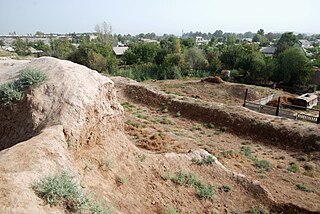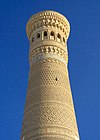
The Syr Darya, historically known as the Jaxartes, is a river in Central Asia. The name, which is Persian, literally means Syr Sea or Syr River. It originates in the Tian Shan Mountains in Kyrgyzstan and eastern Uzbekistan and flows for 2,256.25 kilometres (1,401.97 mi) west and north-west through Uzbekistan and southern Kazakhstan to the northern remnants of the Aral Sea. It is the northern and eastern of the two main rivers in the endorheic basin of the Aral Sea, the other being the Amu Darya (Jayhun).

Merv, also known as the Merve Oasis, formerly known as Alexandria, Antiochia in Margiana and Marw al-Shāhijān, was a major Iranian city in Central Asia, on the historical Silk Road, near today's Mary, Turkmenistan. Human settlements on the site of Merv existed from the 3rd millennium BC until the 18th century AD. It changed hands repeatedly throughout history. Under the Achaemenid Empire, it was the centre of the satrapy of Margiana. It was subsequently ruled by the ancient Macedonians, Seleucids, Parthians, Sasanians, Arabs, Ghaznavids, Seljuqs, Khwarazmians and Timurids, among others.

Khwarazm or Chorasmia is a large oasis region on the Amu Darya river delta in western Central Asia, bordered on the north by the (former) Aral Sea, on the east by the Kyzylkum Desert, on the south by the Karakum Desert, and on the west by the Ustyurt Plateau. It was the center of the Iranian Khwarezmian civilization, and a series of kingdoms such as the Afrighid dynasty and the Anushtegin dynasty, whose capitals were Kath, Gurganj and—from the 16th century on—Khiva. Today Khwarazm belongs partly to Uzbekistan and partly to Turkmenistan.
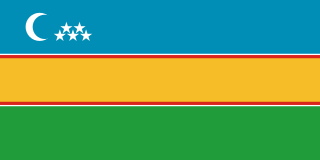
Karakalpakstan, officially the Republic of Karakalpakstan, is an autonomous republic of Uzbekistan. It occupies the whole northwestern part of Uzbekistan. The capital is Nukus. Karakalpakstan covers an area of 166,590 km2 (64,320 sq mi), and a population of about 2 million people. Its territory covers the classical land of Khwarezm, which in classical Persian literature was known as Kāt (کات).

The Karakalpaks or Qaraqalpaqs, are a Turkic ethnic group native to Karakalpakstan in Northwestern Uzbekistan. During the 18th century, they settled in the lower reaches of the Amu Darya and in the (former) delta of Amu Darya on the southern shore of the Aral Sea. The name "Karakalpak" comes from two words: qara meaning "black" and qalpaq meaning "hat". The Karakalpaks number nearly 620,000 worldwide, out of which about 500,000 live in the Karakalpakstan region of Uzbekistan.

Otrar or Utrar, also called Farab, is a Central Asian ghost town that was a city located along the Silk Road in Kazakhstan. Otrar was an important town in the history of Central Asia, situated on the borders of settled and agricultural civilizations. It was the center of a great oasis and political district, commanding a key point connecting Kazakhstan with China, Europe, Near and Middle East, Siberia and Ural.

The Aydar Lake is part of the man-made Aydar-Arnasay system of lakes, which covers 4,000 square kilometres (1,500 mi2). This has 3 brackish water lakes, deep basins of the south-eastern Kyzyl Kum. The lakes are expansive reservoirs of Soviet planning.

Paykend or Poykent, an ancient city in Uzbekistan, is located in the lower stream of Zarafshan River and was one of the largest cities of the Bukhara oasis. The city consisted of a citadel, two settlements, and a rabod (suburb). Paykend is currently under consideration for inscription as a UNESCO World Heritage site.

Koi Krylgan Kala is an archaeological site located outside the village of Taza-Kel'timinar in the Ellikqal'a District in the Republic of Karakalpakstan, an autonomous republic of Uzbekistan. In ancient times, it was sited along a canal in the Oxus delta region.
The Chorasmian Archaeological-Ethnographic Expedition of the Academy of Sciences of the USSR explored a large area of Central Asia, where between 1937 and 1991, its members found and recorded almost 1,000 archaeological sites. It was the biggest and longest-lasting of all archaeological expeditions of the Soviet Union.

Ayaz-Kala is an archaeological site in Northern Uzbekistan, built between the 4th century BCE and the 7th century CE. Situated on a hilltop overlooking the Kyzylkum Desert, the site encompasses the ruins of an ancient Khorezm fortress.

Balalyk tepe, in former Bactria, modern Uzbekistan, is a Central Asian archaeological site with many mural paintings. It was the site of a small fortified manor belonging to a princely Hephthalite clan. It is generally dated a bit later than the painting at Dilberjin, from the late 5th century to the early 7th century CE, or from the end of the 6th century to the early 7th century CE. The paintings of Balalyk Tepe are part of a "Tokharistan school", which also includes Adzhina-tepe and Kafyr-kala. They are succeeded chronologically by the Sogdian art of Penjikent.

Toprak-Kala, in modern Karakalpakstan, Uzbekistan, was an ancient palace city and the capital of in Chorasmia in the 2nd/3rd century CE, where wall paintings, coins and archives were discovered. Its history covers a period from the 1st to the 5th century CE. It is part of the "Fifty fortresses oasis" in modern-day Uzbekistan.

Akchakhan-Kala, or Akcha-khan Kala, also named after the locality Kazakly-Yatkan/ Kazakl'i-Yatkan, in modern Karakalpakstan, Uzbekistan, was an ancient fortress in Chorasmia built in the 4th/ 3rd century BCE and occupied until it was despoiled in the 2nd century CE. It is part of the "Fifty fortresses oasis" in modern-day Uzbekistan. The abandonment of Akchakhan-Kala was apparently followed by the establishment of the new capital of Toprak-Kala, 14 km to the northeast.

Guldursun-Kala, also Guldursun Qala, in modern Karakalpakstan, Uzbekistan, was an ancient fortress in Chorasmia built in the 12th century CE. It is one of the largest fortresses of Khwarezm, with perimeter walls of about 1 kilometer in total length, and an internal area of about 6.4 hectares.
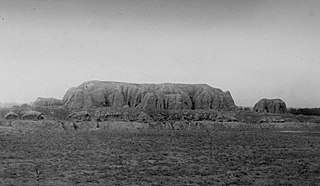
Kafir-kala is an ancient fortress 12 kilometers south of the city center of Samarkand in Uzbekistan, protecting the southern border of the Samarkand oasis. It consists in a central citadel built in mud-bricks and measuring 75 × 75 meters at its base has six towers and is surrounded by a moat, still visible today. Living quarters were located outside the citadel.
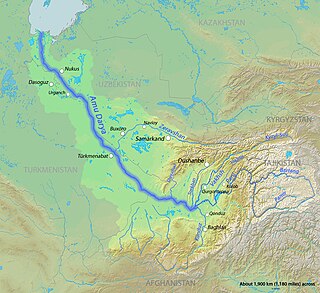
The Gurgānj Dam was a major water engineering project of medieval-era Central Asia. The dam was constructed on the Amu Darya river, near what is now called Konye-Urgench in northern Turkmenistan.
























